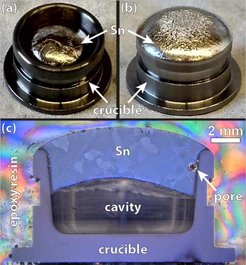Liquid Tin as a Divertor Material
For application as divertor target materials, liquid metals, for example tin, are interesting as an alternative to solids. In recent experiments, however, tin displayed a number of unexpected effects in contact with hydrogen plasmas.

The extreme requirements for divertor materials can possibly be met by the use of liquid metals such as tin. First prototypes were promising in high heat flux tests. The interaction with hydrogen plasmas, however, has barely been investigated. A series of recent experiments performed at IPP showed several unexpected and dramatic effects. Just below its melting point, tin forms a sponge-like layer with a high hydrogen content. Gas bubbles are formed in liquid tin, which are swept into deeper layers by the motion of the melt. This can form larger gas pockets in the liquid metal reservoir, as shown in the figure. Similar to air in a cooling circuit, this could lead to malfunction of the liquid-metal divertor. The formation and coalescence of gas bubbles must therefore be taken into account and possibly prevented in further development of this technology. On the other hand, irradiation with a hydrogen plasma improves the wettability of the carrier material (e. g. tungsten) with tin. This may simplify the fabrication of liquid tin divertor elements considerably. This work was published in in the journal Nuclear Fusion (Manhard et al 2020 Nucl. Fusion https://doi.org/10.1088/1741-4326/aba801).

